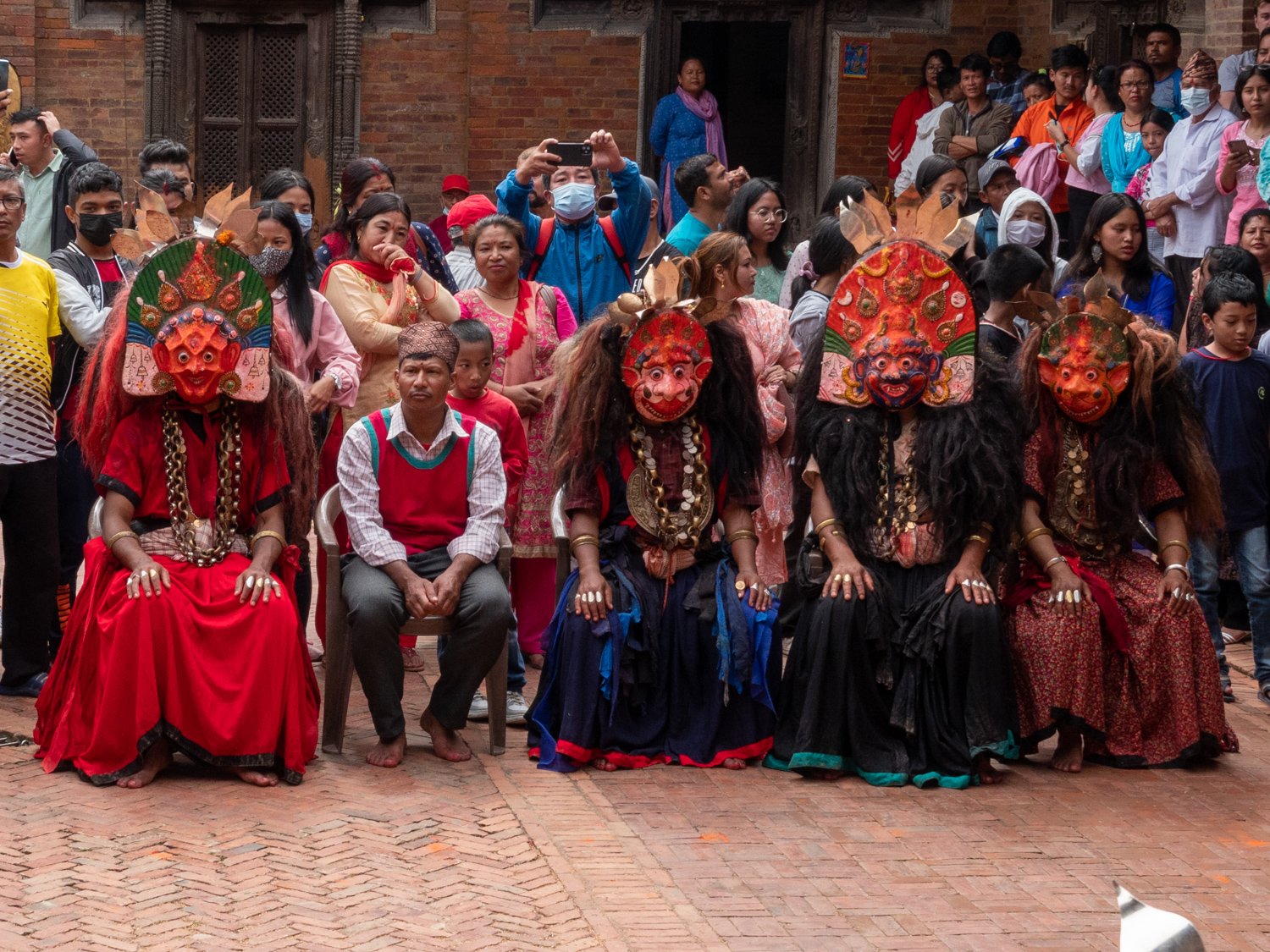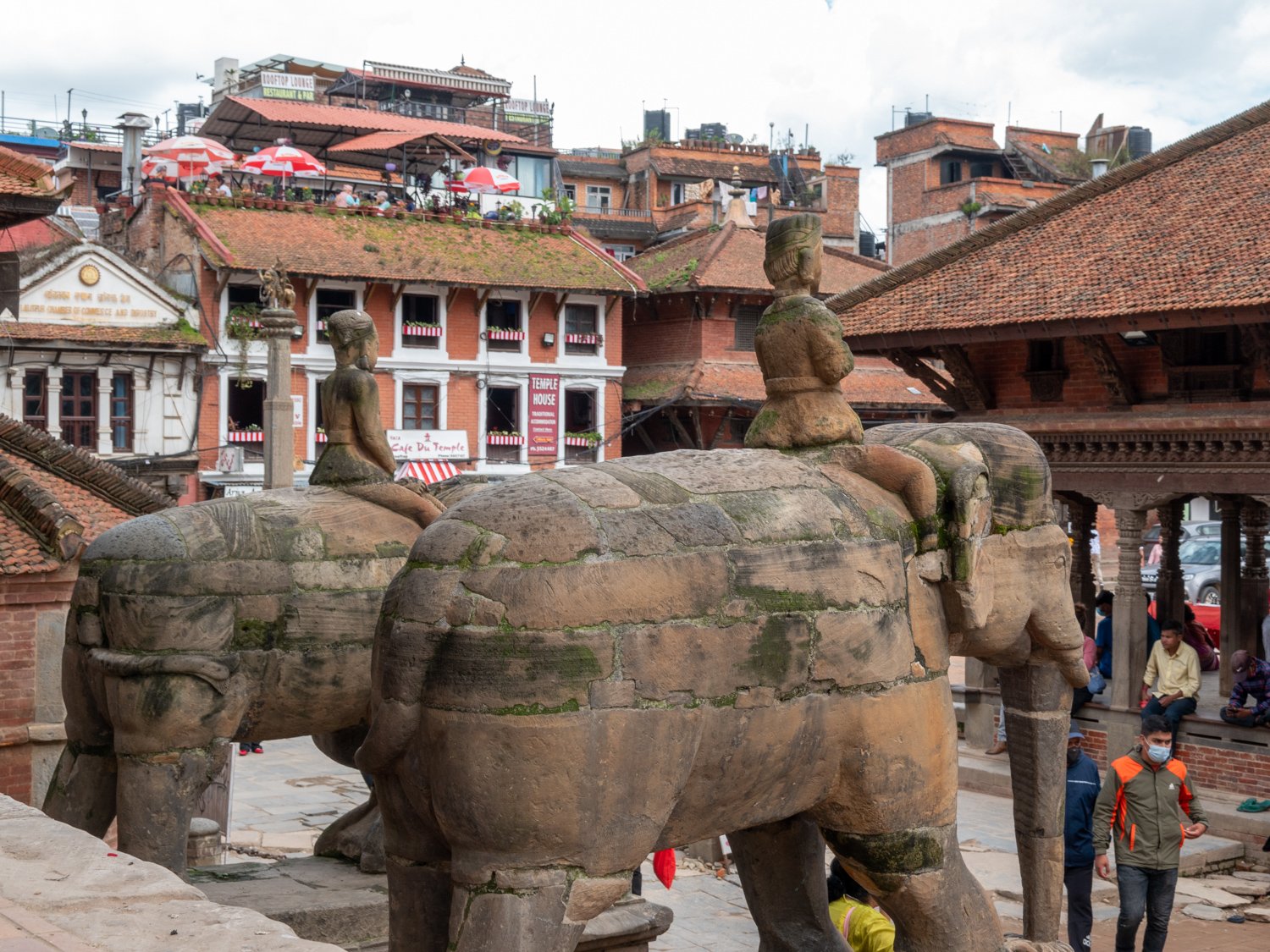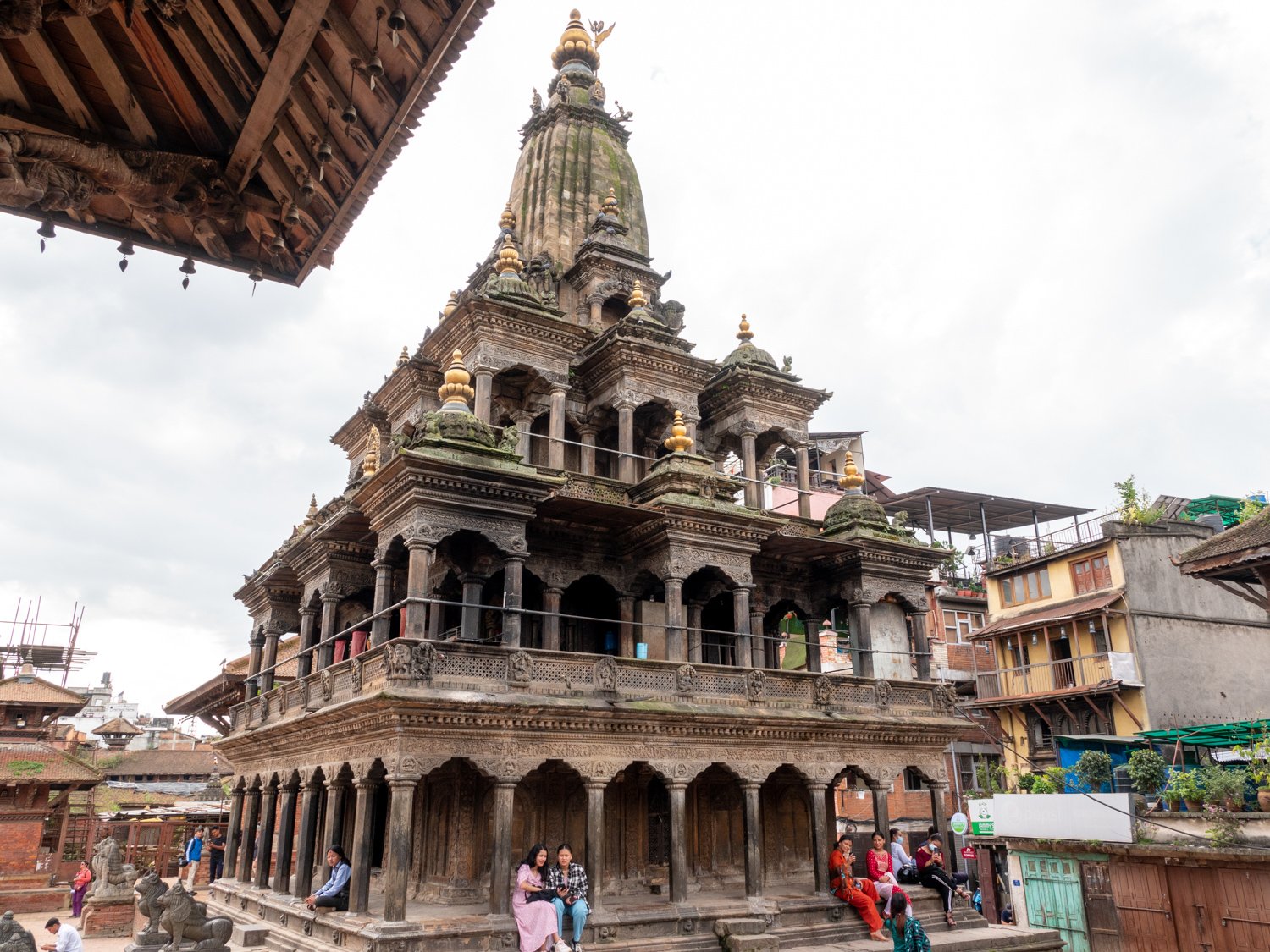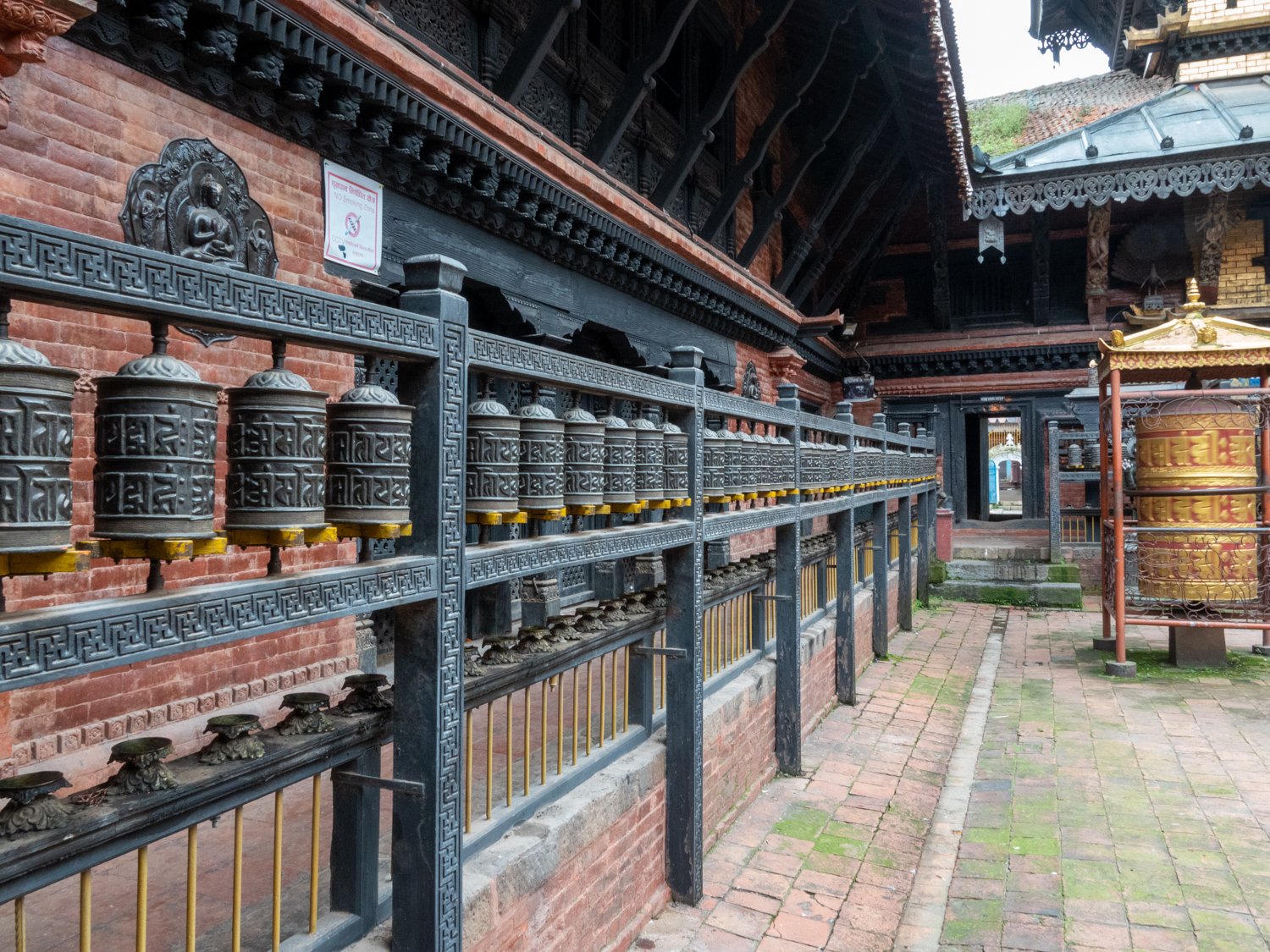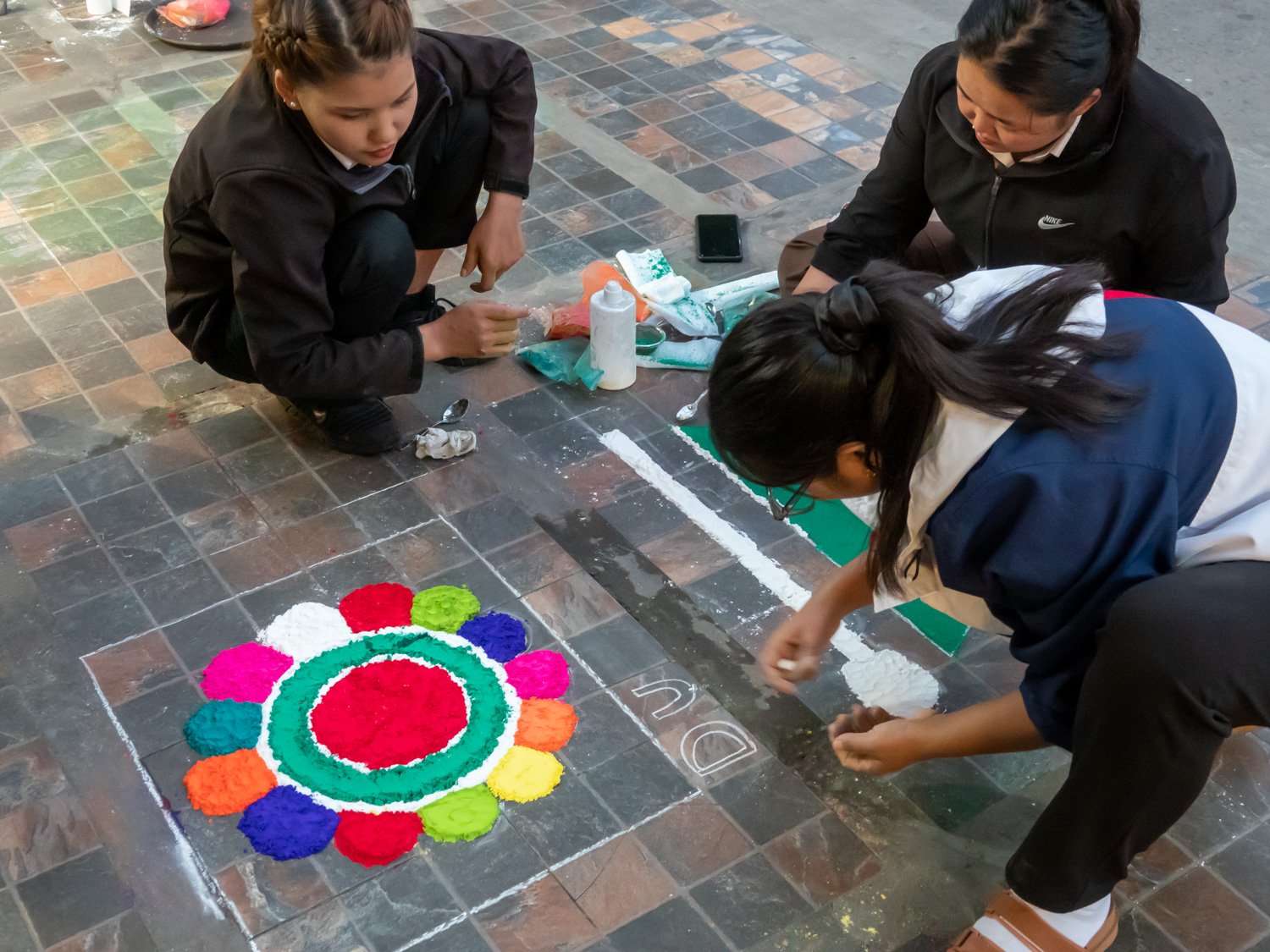Kathmandu
On both ends of my trek in Nepal, I spent a couple days visiting Kathmandu and it’s environs. This turned out to be an especially pleasant and surprising aspect of the trip as I had not prepared myself for the rich cultural attractions of Nepali society. I was particularly lucky in that my visit bracketed two important Hindi festivals, Dawain and Diwali.
Patan
After arriving at the Kathmandu Airport after a long flight from Chicago via New Delhi at 9 PM local time, I had to find my way to Patan and the Airbnb I had rented. Fortunately my Airbnb host was super accommodating and helpful. He had sent detailed instructions on how best to get a taxicab at the airport and gave me his cell phone number which I gave to the taxi driver. The driver called the host who then gave him instructions on where to meet him. The Airbnb was on a very narrow alleyway within a maze of streets that would have been impossible to find without assistance.
The Airbnb is one of the doors on the left
One of the first things I noticed in Kathmandu was the traffic pattern. In 3 days in Patan, I did not see a single stop sign, red light, traffic cop, or any other traffic control. It seemed like the only rule is to generally “stay on the left”. The streets are impossibly narrow and teeming with cars, motorcycles, bicycles and pedestrians. As a pedestrian when trying to cross a busy street, you look for a slight break in the traffic, put one hand out as if to block the traffic in one direction, and do the same with the other hand and hope that everyone stops for you. It’s a bit unnerving at first but generally effective.
Durbar Square
This is the primary point of interest in Patan, the area around the old palace with numerous ancient temples. My Airbnb was an easy 15 minute walk though my host had to help me find the way through the maze of narrow alleyways and streets. He had me take photos of the critical intersections so I would be able to find my way back on my own.
I began my exploration by visiting the old palace where there was some kind of ceremony going on in the courtyard. A group of 4-5 men were seated playing music while some masked woman (?) danced slowly. Off and on a fellow played a flute-like instrument with a haunting tune. There was also a considerable audience obviously waiting for something to happen. I watched the ceremony unfold slowly before I realized that there was going to be an animal sacrifice. There was a collection of long knifes and a lamb was led into the center of the arena. There was an extended ritual of scattering water and other stuff before each of the musicians and those seated in a circle. The sacrifice itself was shielded a bit by the 5 men that it took to hold the animal in the air. But the blood spurting onto the ground gave a clear indication of what was going on. Surprisingly, there was no attempt to keep the blood confined to a bowl; it simply fell onto the cobblestone. And almost everyone was barefoot.
When they led in a large water buffalo, I decided that I had seen enough and left the enclosure. In the back courtyard where the animals had been kept, there was a bare skull of a buffalo along with a pile of what looked like its meat simply stacked on the ground. It looked like the skull had been there for days for it was scraped clean. I have no idea if the meat of the animals was saved to be eaten but it seemed odd that it wasn’t refrigerated.
Nepal is well-known as a country in which the Hindi and Buddhist religions co-exist peacefully. Indeed there are many temples of both faiths throughout the country. In thinking about what I had just witnessed I was struck by the dichotomy of these two major religions. Buddhists will go out of their way so they don’t step and kill an ant while the Hindi religion, at least certain sects, sanction animal sacrifices, for no apparent reason other than to pacify a certain god. Apparently there have been holidays in past years in Nepal in which small villages sacrifice tens of thousands of animals during a single holiday.
I had some very interesting conversations with my Airbnb host during breakfast so I was curious about his thoughts on the practice of animal sacrifice. He said he was a practicing Hindi and that when he was young (the Airbnb building was built by his grandfather so he has spent his whole life living within arm’s throw of Durbar Square) he had witnessed the practice I had seen. But he never went to see it again. So without actually saying it, he was pretty clearly against this ritual. I happened to see it because this was the last day of the Dawain Festival.
Durbar Square Patan
Entrance to the old palace
Ceremony in the courtyard of the old palace
Victim #1
Note the blood spurting on the ground and everyone in bare feet.
Victim #2
The remainder of the time in Patan, I wandered about to see the ancient temples and interesting art.
A royal water fountain
The Rato Machhendranath Temple
Statue of King Yoganarendra’s (1684-1705), one of a long line of Malla kings
Just north of Durbar Square is the Buddhist Golden Temple (Kwa Bahal) which dates to the 12th century with a white stupa, prayer wheels, and intricate ccourtyards. When I visited the temple was very empty but presumably there are more who come near dawn and dusk. The courtyard has a long line of prayer wheels that are spun in a clockwise direction while walking around in the same direction. The direction is important because that is the direction that the mantras on the prayer wheels are written.
The monks had just finished lighting all of the candles
Large prayer wheel in the courtyard
One walks around the courtyard in a clockwise direction and spins the prayer wheels in the same direction.
Pashupatinath Temple, Kathmandu
One day I visited one of the most holy Hindi temples in Nepal, the Pashupatinath Temple dedicated to the god Shiva. In addition to the temple, which is off-limits to non-Hindi, there is an extended area along the river where cremations are performed.
Cremation platforms along the sacred Bagmati River
Note the kids swimming in the river across from the cremation platforms
There are a large number of the Sadhu holy men scattered around the temple grounds. The Sadhu are religious ascetics who have renounced worldly life and devote their lives to meditation and contemplation, depending on donations. If one wants a photograph of a Sadhu, one is expected to give a donation of unspecified size.
Boudhanath stupa
The Boudhanath stupa is one of the largest Buddhist stupas in Nepal and the world. The stupa was badly damaged in the 2015 earthquake but it has been rebuilt.
Large prayer wheel
Durbar Square Kathmandu
I walked to Durbar Square in KTM on a free afternoon. It was difficult to find my way as there are virtually no street signs and I was trying to avoid using Google maps.
Bhaktapur
Another interesting area near Kathmandu is the ancient capital Bhaktapur which has its own Durbar Square and collections of ancient temples and palaces. It also suffered damage during the 2015 earthquake so there is considerable rebuilding going on. I visited Bhaktapur with Denise and Helen after coming back to Kathmandu following the trek.
Durbar Square
There is similarity in the Durbar Squares in Patan and in Kathmandu though on the day we visited, Bhaktapur was considerably quieter than Kathmandu.
My companions Denise and Helen in Durbar Square
Earthquake damage
Diwali Festival
I was fortunate to be in Nepal during the Diwali Festival. In Kathmandu almost all establishments made colorful mandela-like decorations on the sidewalk just out the front door. At night while walking back to my hotel after dinner, the streets were crowded with people, most of them congregating at the entrances to hotels or bars or restaurants where there was a troupe of singers and dancers performing. The range of dances was quite broad, from what I would consider to be traditional folk dances or here, to ones that resembled seductive belly dancing or modern street dancing or undescribable. I did not appreciate how much the Nepali culture is based on dance and song.
A typical Diwali Festival decoration
Please note: All text and photos are copyrighted to Tom Yin. You are welcome to share the URL, however re-production of text or photos is not permitted. If you would like to feature this story, contact me and I would be happy to provide you with details, photos, text etc. Thanks!










